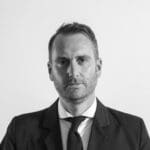In this series, Global Outlook on Sustainability author Richard Cope explores how Mintel’s sustainability research relates to government issues, business issues, the sustainability roles and responsibilities of consumer-facing brands, and current popular culture.
What Green can learn from pink
Apologies for being late to the Barbie party (and adding to the growing mountain of media commentary), but I believe the sustainability movement – specifically corporate transparency and public consciousness – can learn a few things from Mattel’s marketing tactics and the movie’s satirical stabs.
That may seem hard to accept at first. We’re talking about a film that glorifies consumerism, one that exhausted global supplies of pink paint and one that will increase – by millions – sales of plastic dolls that each cause 660 grams of carbon emissions. Yet, despite all that, in marketing its legacy could yet be positive. Whilst Barbie has no green agenda and Mattel are solely pushing product rather than any green PR (being quiet about any behind the scenes doll recycling or sugar cane based plastics initiatives) by addressing ethics and their past sins head on they’re opening up new routes to follow for other businesses seeking to pivot or progress.
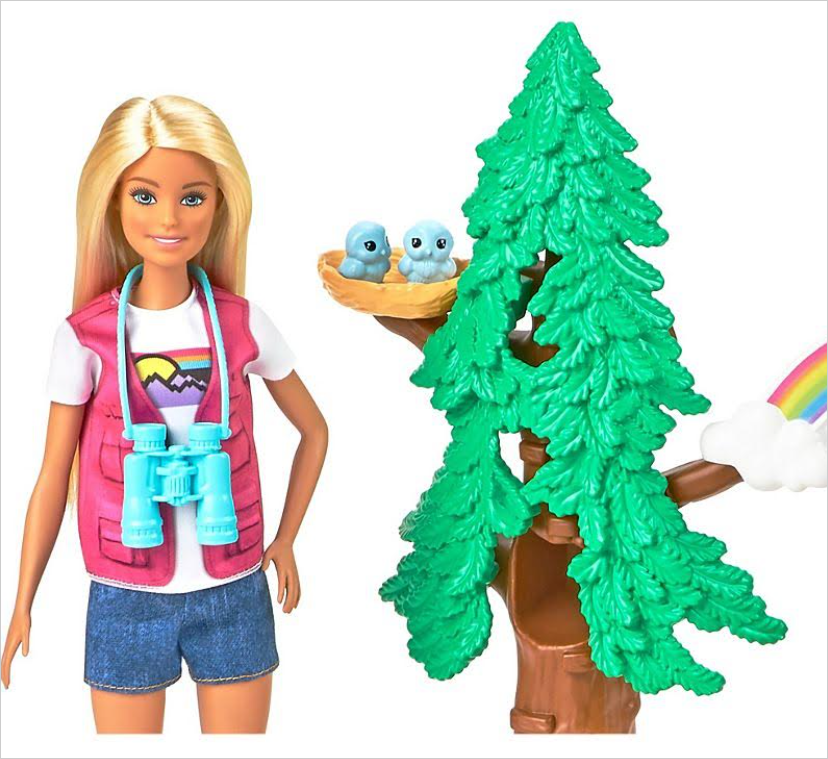
For all its heart and dazzle, in the near future Barbie will be remembered less as a movie and more as a most outrageous example of self-reflexive rebranding on the part of its producer (and subject) Mattel. The brand has performed an incredible act of Contortion – defined as “the skill of twisting and bending one’s body into strange and unnatural positions as a form of entertainment” – that sees it ridicule its supposed contribution to (and profit from) gender clichés, reinvent itself, move on and then make even more money in the process.
I once authored a marketing trend called Accentuate the Negative which argued that due to the sense of intimacy engendered by social media, brands could admit mistakes and apologise to us on the same platforms as our friends, bravely showing us a fallible face and appearing more human in the process. This approach is resonating with Barbie’s audiences too. The nostalgic affection in which the Mattel brand is held, even by adults who were self-aware enough to scalp and torture their dolls in their youth, is of course helping this process. I won’t get bogged down in a debate about the morals of Mattel having its cake and eating it too, but this does suggest how transgressive companies that have previously profited from plundering the natural world and exploiting its people (ie most of them) might also find exit routes to redemption as part of a very necessary process to acknowledge, apologise and adapt .
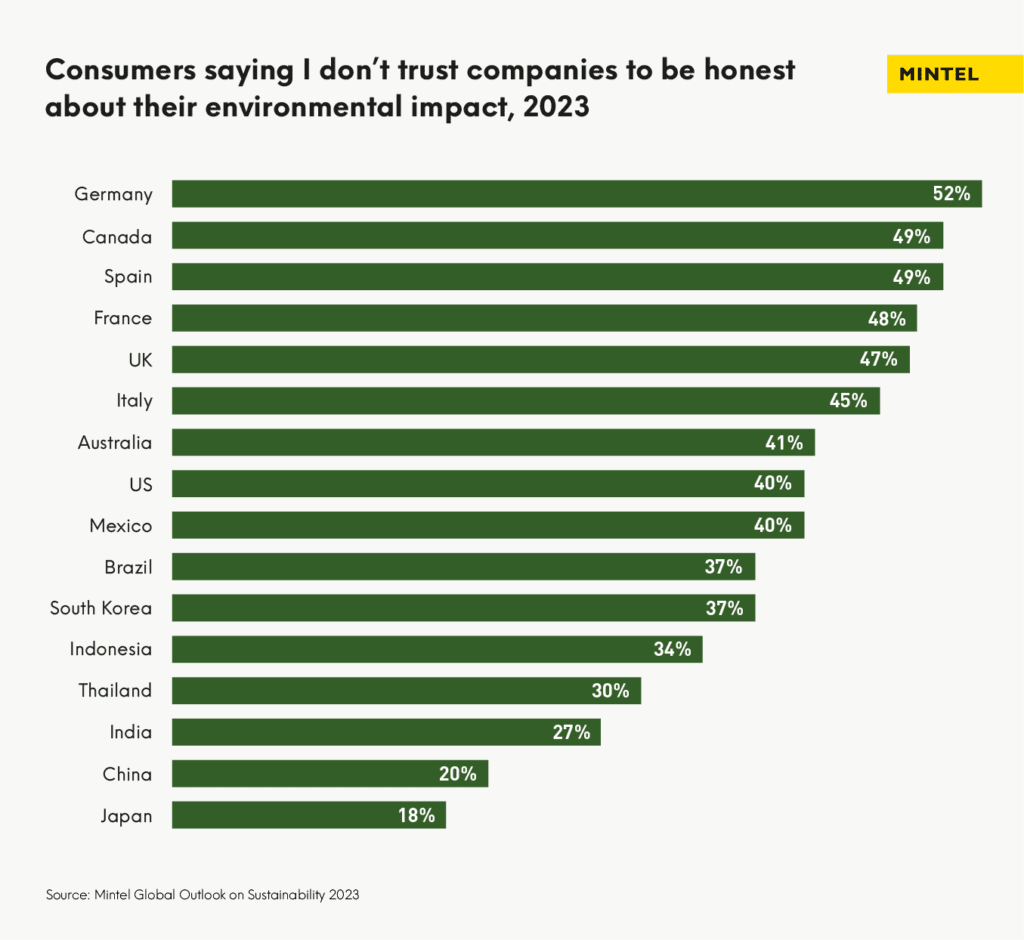
In the movie, Mattel doesn’t sweep things under the carpet early and change direction: the confessions keep going right through until those end credits accompanied by shameful yet hilarious gallery of withdrawn bad taste Barbies. In doing this, the movie creates a new brand landscape, where contrition is possible if sugared with humour and the promise of genuine change. It’s possible to envisage more companies ‘fessing up to their historic impacts and even making them humorous if they spread and share the guilt with us and look at how “we” (brands and customers) used to behave badly.

Had Kenough of living in our own Barbie world?
The other lesson I took from Barbie is more conceptual and relates to growing engagement.
Whilst doing little for the United Nations Goal of Responsible Consumption and Production, as a cultural phenomenon, Barbie turns Goal #5 on Gender Equality a day-glo shade of pink and puts it at the forefront of a host of urgent, worthy and deserving environmental and social issues that are competing for consumers’ attention and their custom. This acts as yet another reminder that successful sustainable causes will need to deliver persuasive human elements when championing their benefits. Barefoot College’s Solar Mamas venture that trains rural women in solar technology installation is a stellar example of this.

One of its messages and themes is that we all need to consciously wake up. Though it is admittedly beyond the movie’s intentions, that need to become more aware and responsive to our surroundings extends and translates to our environment too. In our own realities, too many of us are “Kens” to a degree: performing empty roles, whilst being accessories to the damage we’re causing too. We’re also everyday “Barbies” in the sense that the water we drink or shower with is ‘make believe’ in that we’re entirely disconnected from the realities of where it comes from or where it goes. We figuratively drink and bathe ‘without getting wet’ and then just continue to Dance the Night (away).
In the centrepiece of the film Ken and Barbie escape from the artificiality of Barbieworld into the (ironic spoiler alert) “real” world of Los Angeles. We’re all going to need similar excursions into the realities of our environment (see our ‘Nature.Is. Amazing’ blog) if we’re ever going to care about avowed UN goals around things like Life on Land or Life Below Water and begin to understand what our real roles are whilst we’re still here.
Duty is in the eye of the beholder
Published 8 Aug 2023
Art can push climate change up our agendas by depicting disaster, but it can also suggest ways for business and government marketers to visualise and sell in their responses, instill public hope and inspire action. A new exhibition shows us how.
Dear Earth: Art and Hope in a Time of Crisis at London’s Hayward Gallery presents 15 artists rallying around Otobong Nkanga’s ‘caring is a form of resistance’ manifesto to deliver timely reflections on what we’re already losing and where we can act.
As discussed in my article on sustainability in cinema, the best art (be it ‘high’, or ‘low’) always holds up a mirror to popular culture and that is where Dear Earth feels so razor sharp and of the moment—there is a palpable sense that ‘this is happening now’.
Andrea Bowers’ neon sign Climate Change is Real is a case in point, depicting our predicament as a 24-hour, commercially-driven entity, a series of consumer choices ‘open for business’, whilst the same artist’s sculpture Memorial to Arcadia Woodlands Clear-Cut (Green, Violet and Brown) commemorates a forest in California that has already fallen to progress.

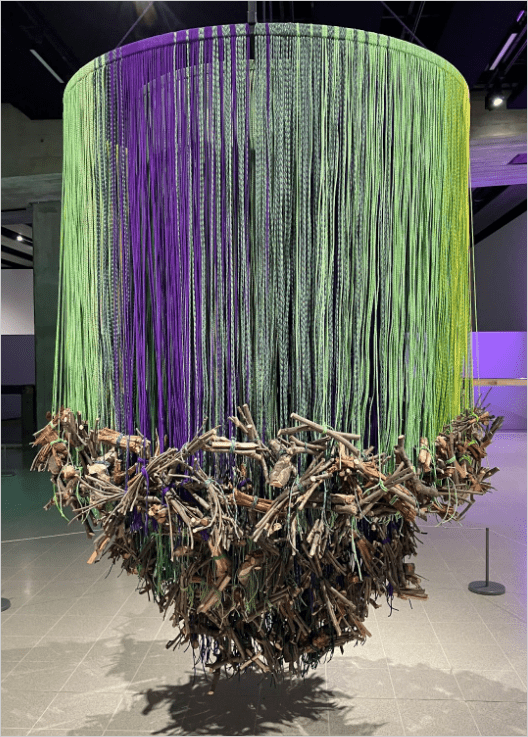
Video installation We are opposite like that by Himali Singh Soin features an alien visitor touring Earth’s blighted, melted landscape of broken fossil fuel infrastructure and immediately calls to mind dystopian ‘science fiction’, until we realise that we’re looking at the long-discarded polar wreckage of the here and now.
Something like Apple TV’s Extrapolations looks pale by comparison. However spectacular, well-intentioned and potentially influential it may be, it feels off target and instantly dated. Its ‘introduction of a near future where the chaotic effects of climate change have become embedded into our everyday lives’ already superceded by this summer’s reality TV drama of fires, floods, heroism and Greek tragedy.

Elsewhere Dear Earth publicly shames us into reconsidering our actions, as Jenny Kendler’s Bird Watching III creates a rooftop standoff between the viewer and the beautiful, hateful eyes of one hundred birds faced with extinction from climate change.
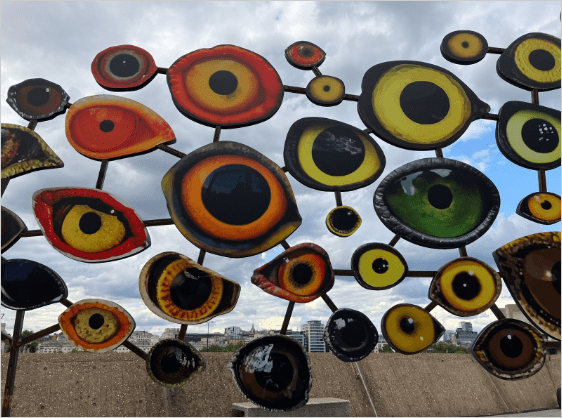
The same artist’s Tell it to the Birds translates one’s voice into birdsong and it’s here that powerful, engaging marketing messages begin to emerge. Creating a sense of connection with nature will be essential for us to empathise with the victims of climate change and react emotionally and positively to the responses on offer. This craving for connection is also the theme of Daiara Tukano’s ‘cosmo vision’ paintings of a forest ‘that is living, that is talking and telling stories’.
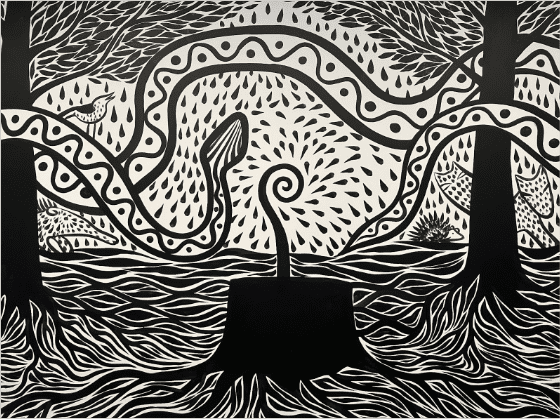
The pleasure of Tukano’s paintings is matched by Richard Mosse’s digital prints of oil spills in the Amazon basin. By using multispectral imaging techniques, these photos capture colours ‘beyond human perception’ and conjure up considerations around the illusory nature of the beauty we can perceive right now and the dangers that lie beneath it and beyond in time.

To achieve their peak penetration, our environmental solutions must look just as beautiful and heed the oft-followed advice of 1940s American supersalesman Elmer Wheeler: ‘Don’t sell the sausage—sell the sizzle!’. It’s unsurprising that the majority of consumers in our research agree that statistics can be depressing, so it makes sense to sell the vision of a better future, before reiterating those dire dystopian alternatives.

Agnes Denes is an artist who excels in visualising better futures (and aesthetically pleasing ones at that), whilst extolling the appeal of local community and tangibility. Her two-acre Wheatfield – A Confrontation planted next to Manhattan’s World Trade Centre back in 1982 was a striking lesson in waste, greed and land-use in relation to society and newer works featured at Dear Earth further explore these concerns and hopes.
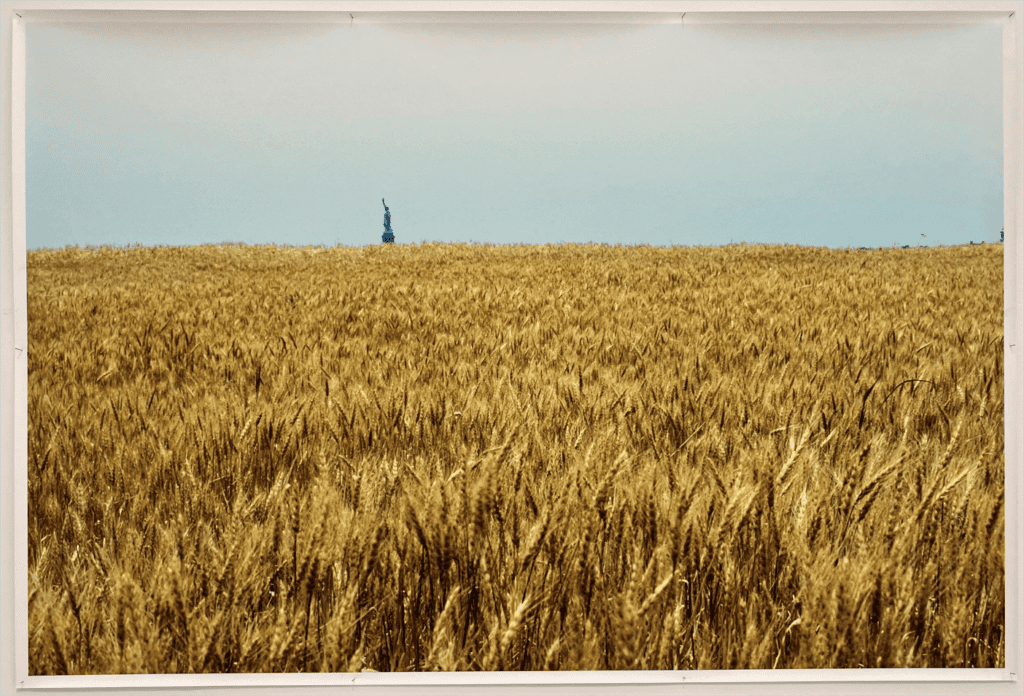
Her Living Pyramid and Tree Mountain works showcase how humanity can literally support new attractive, stimulating environments where nature can flourish. By creating structures and platforms for wildflowers and grasses to grow and endangered fir trees to recover, Denes is an inspiration for engineers and marketers alike, showing how we might successfully harmonise environments and sell in an appealing vision of how to work with nature—or bring it closer to home.

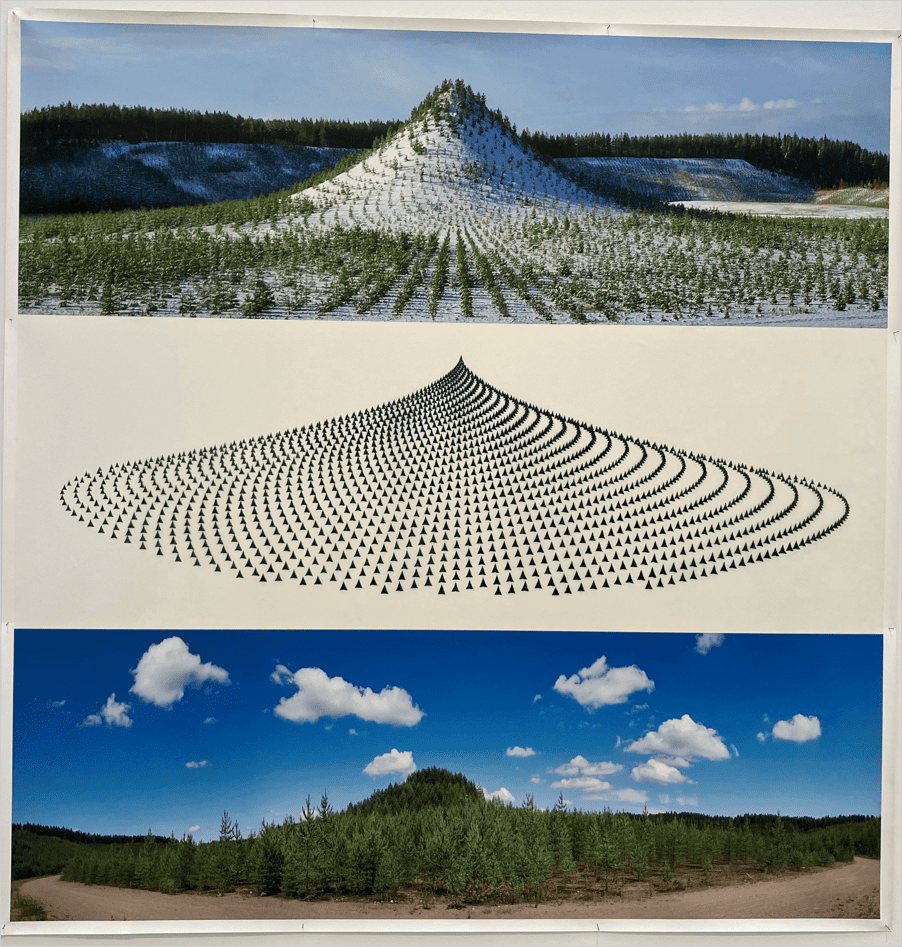
Without wishing to become trite, 69% of consumers are seeking to participate in solutions that help the environment and make them ‘feel happy’. In that regard, Dear Earth fulfils its promise of delivering ‘hope’. Yes, it laments lost environments, leverages guilt and calls for urgency, but – more importantly – it calls for a connection with nature and, secondly, for an attempt to replicate and celebrate its beauty when promoting our attempts to reconcile ourselves with it.
Environmental étiquette
Published 2 Aug 2023
The French have pioneered and shared many great things with the world—hot air balloons, pasteurization, the Aqua-Lung and braille among them. Clear, on-pack labels (‘étiquettes’ in French) to promote the purchasing of less impactful food products could be next. Two of the most prominent environmental rating systems in France are the Eco Score and Planet Score—but how do they work?
ADEME’s Agribalyse’s methodology for Eco Score adopts a Life Cycle Assessment (LCA) approach (based on analysis of 2,500 different product categories), calculating each product’s cumulative impact across the stages of production, processing, packaging, distribution, retail and consumption.

Source: agribalyse.ademe.fr
These LCA elements generate a score out of 100, but further points can be won or lost according to further criteria around packaging recyclability, labelling, ingredients provenance and seasonality. The final result is manifested as a colour-coded A-E score with a dark green colour being the least impactful (or “best”) score a product can receive.
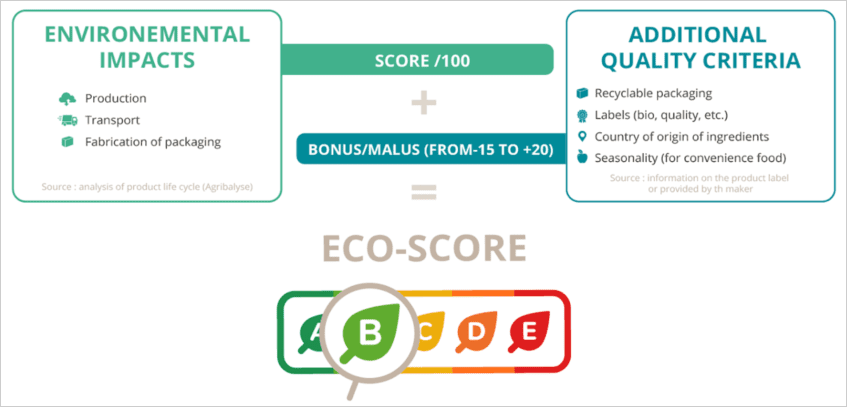
Source: agribalyse.ademe.fr
The Planet-score rating has also been devised using the French state’s Agribalyse ADEME database. Its methodology is also based on the fact that agricultural production generates on average 85% of food, but also factors in—and highlights—the impacts of pesticides and antibiotics on the environment and biodiversity and claims that a clear majority (48%) of consumers favour it for those reasons. Planet-score has rated over 700,000 products and has been embraced by over 200 food companies.
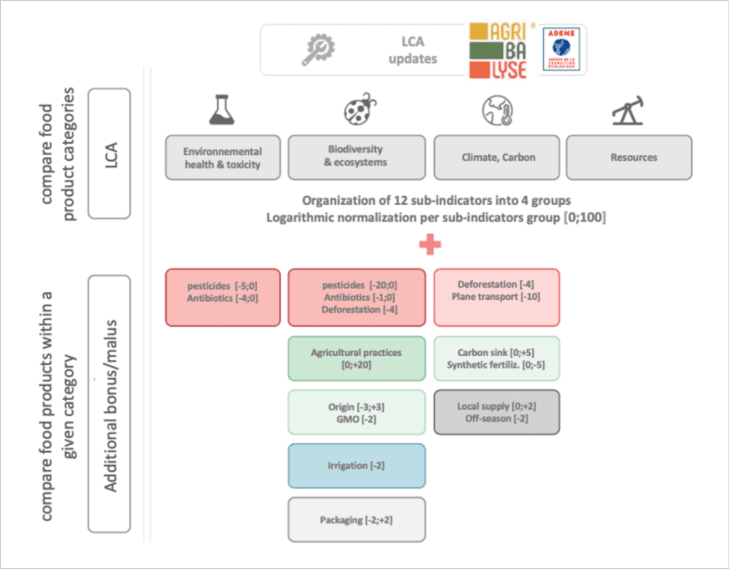
Source: planet-score.org
The precedent for these initiatives dates back to 2017, when the French government introduced voluntary adoption of the Nutri-score labelling scheme, ranking the health of food from A to E. By early 2021, over 500 companies had adopted the label in France and Belgium and the results from Santé Publique France’s 2020 survey suggested that it could foment behaviour change: 57% of French respondents who were aware of the logo had changed at least one of their purchasing habits and over a third had chosen a product with a better score or limited purchases of products with lower scores.
For consumers, the adoption of a lifecycle assessment approach wrapped up in a single label might ultimately liberate them from a dizzying, distracting and confusing array of competing organic, fair trade and FSC claims. It will also deliver a reality check on the fact that agriculture’s impact is mostly in its sourcing. This will shift their attention away from preoccupations with a product’s end of life (where 54% think coffee’s impact is greatest according to our sustainability research) towards its initial sourcing impact (identified by just 21%).
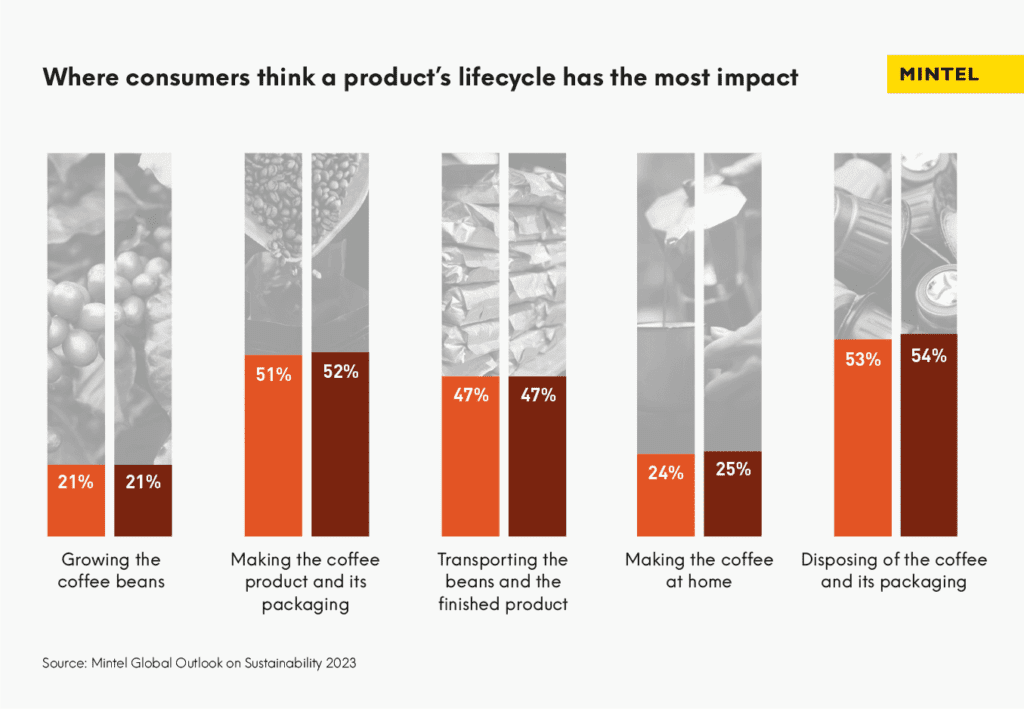
Eco scores can also deliver vital information in the way that consumers desire in order for them to make considered choices. When asked what would convince them to consider buying more responsible products, Mintel research reveals the top response (at 41%) is “labelling that provides a score of how environmentally friendly it is (eg colour coded, 1-5 score)”.
Labelling can empower consumers to genuinely make a difference through more conscious grocery purchasing, with Eco-score’s methodology stressing how food production generates up to 30% greenhouse gas emissions, 60% of drinking water consumption and the majority of our packaging waste.
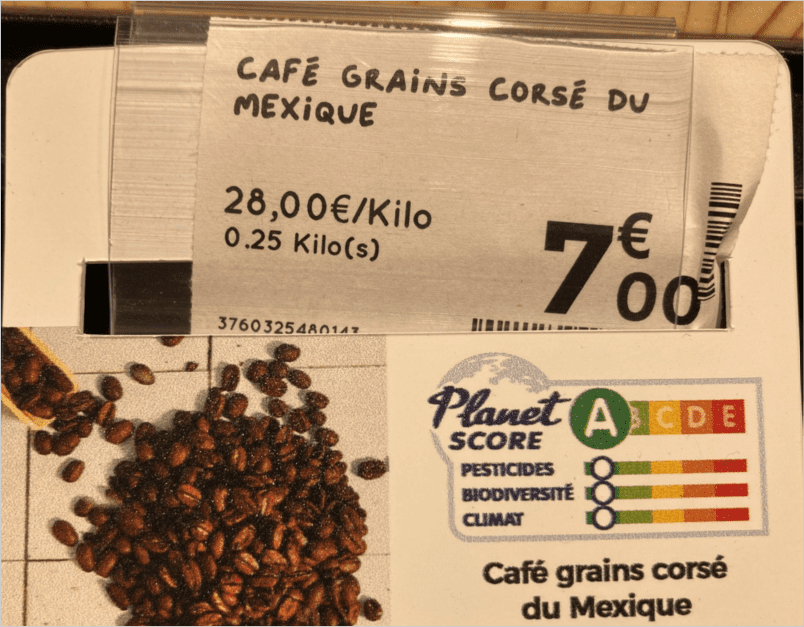
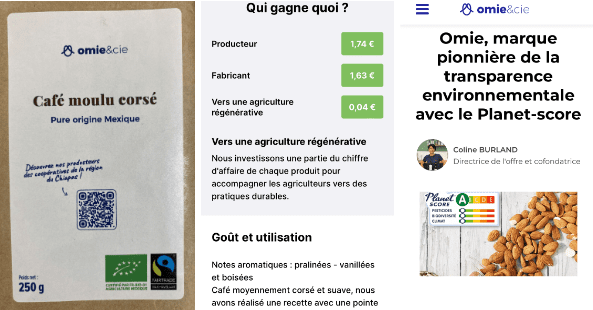
Based on the experience of Nutriscore, the best practice principles of good business hygiene will see more and more businesses adopt eco-labelling and consumers will start to make more informed selections.
A wider European directive may force the issue as well. In 2021, the European Commission registered a European Citizens’ Initiative (ECI) calling for a “European eco-score” to inform consumers about the ecological impact of different products and services. Euractiv has recently shared a leaked impact assessment stating that the EU’s framework for a sustainable food systems (FSFS) law will “incentivise business operators to go beyond minimum sustainability requirements in order to raise the grading/scoring ladder of the harmonised sustainability label and/or benefit from the potential price premia for more sustainably good products”.
Harmonisation is key to avoiding the plethora of packaging recyclability labels that have served only to confuse consumers and stall action. The good news is an eco-score framework will compel claims to be “impactful” within its parameters and remove peripheral or misleading ones, whilst educating, and simplifying things for, the consumer.
Mintel research shows that 64% of consumers like the idea of a ‘shop where all products are sustainable’. Whilst eco-labels won’t deliver that, they will bring the ‘convenience of curation’ which is what modern lifestyles demand.
Advertising battles: Get out of ‘Sour Milk Sea’
Published 25 July 2023
An ingenious, viciously satirical campaign from the American dairy lobby plays fast and loose with notions of ‘real food’ and appeals to some of the worst aspects of tribalism, but offers some harsh lessons for low-impact products in the process.
Wood Milk is a recent addition to a long line of milk alternatives and has some unique selling points. One, it’s made from trees. Two, it’s made for idiots. And three, it’s not real, being paid for by America’s Milk Companies, in a bid to repulse the territorial advances made by a dairy alternatives market winning customers on perceived health and environmental grounds.
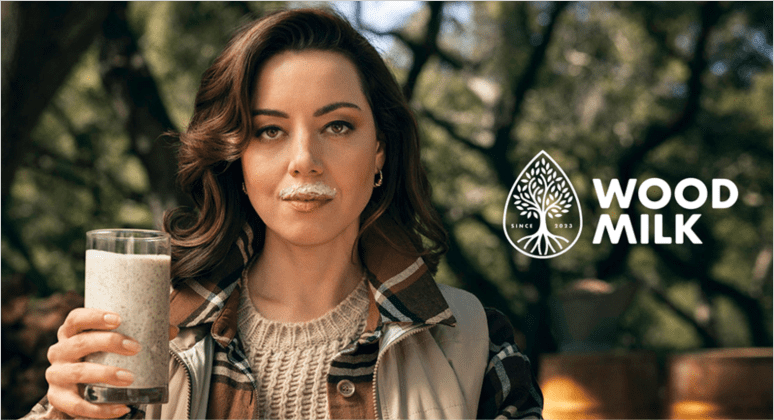
Dairy marketers are understandably concerned. Data from Mintel’s Global Outlook on Sustainability report reveals that the proportion of people reducing their dairy intake has risen by three points between 2021 and 2023 to reach 17%. When we asked consumers what was in their shopping basket last week, some 24% said dairy alternatives. Whilst this is three times less than dairy products, the penetration levels are much higher than for meat alternatives (see chart).
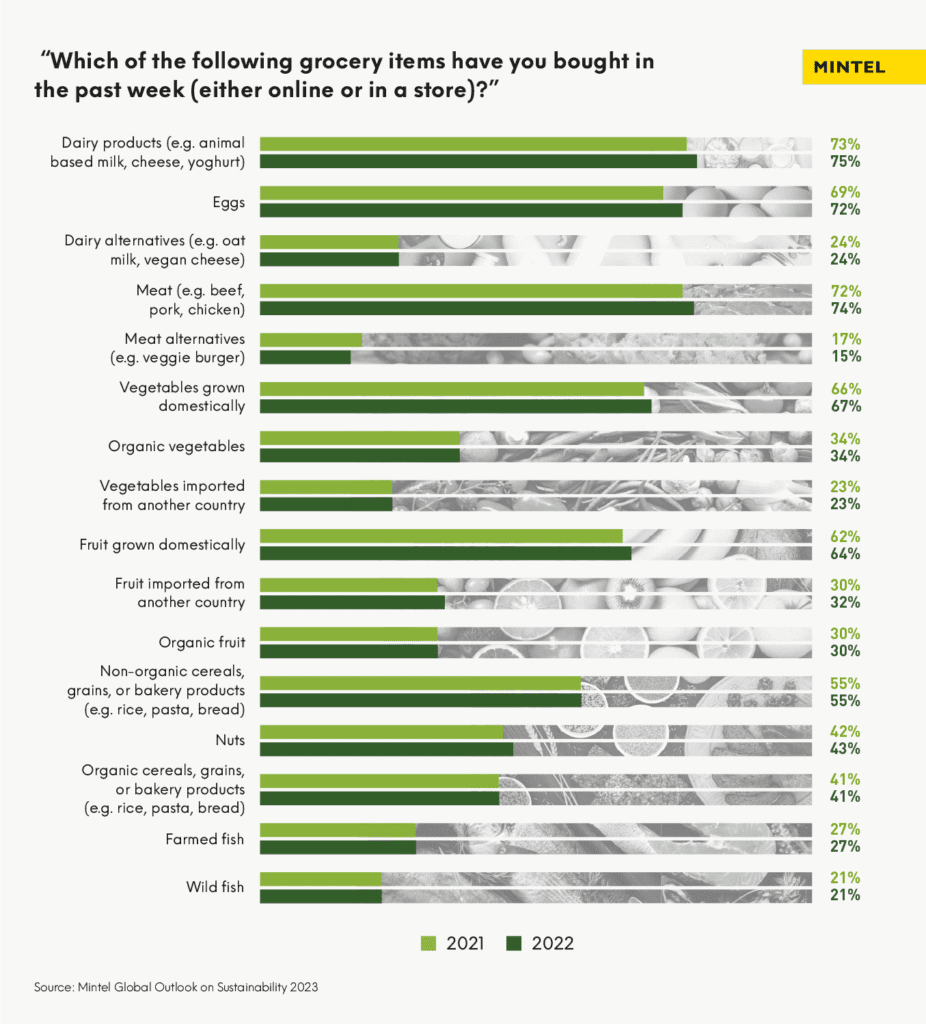
We also see that, whilst just 10% of global consumers tell us they believe that eating fewer dairy products is a way they can make a positive impact on the environment, a superior 17% are doing so, presumably for their perceived health benefits.
Given that worrying stat, it’s no surprise that the America’s Milk Companies’ website is called gonnaneedmilk.com and that it pushes a health agenda. It even competitively asserts milk’s superior nutritional and economic credentials for leading a healthy, athletic, good value lifestyle, with a designated “Milk vs.“ section where rival goat and oat milks are variously dismissed for their weaker nutritional density, higher costs or reliance on ‘unnatural’ fortifications.
The tone of the wider campaign feels targeted against fads, the naive acceptance of ‘trendy terms’ like superfoods, suspicious synthetics and perceived elites (Wood Milk’s backer is a misinformed actress). In its place, we see a focus on the traditions of ‘real’ dairy and its comparatively unprocessed credentials based on the same trust in ‘natural’ that is leveraged by the paper packaging industry to achieve a halo of purity. The fact that paper is made from the same ‘tree farms’ as Wood Milk should act as both a warning and a wake-up call.
It should be noted that the Wood Milk campaign is not ‘anti-sustainability’ as long as cows stay in the picture. It champions organic milk and the benefits of eschewing genetic modifications, synthetic fertilisers, growth hormones and antibiotics.
Dairy alternative competitors that claim to have lessened their impact or champion how they remove animals from the equation can also strive to adopt humorous or tribal approaches to Wood Milk, but they would also do well to learn from its data-driven, myth-busting approach to asserting credentials.
One of the recurring threads running through our new, global sustainability research is that less impactful /more responsible products need to first and foremost assert their non-environmental credentials – be they around health, value, individuality or image – before pressing people’s green buttons. That goes as much for EVs and home solar panels as it does for what you put on your cereal or in your coffee.
Like every other product, milk is becoming unaffordable: in 2022, the UN’s FAO Food Price Index (FFPI) reported dairy’s 19.6% price rise was its highest since 1990 and the price gap with ‘unnatural’ alternatives will begin to close.
Until then, in our politically-polarised world, it’s tempting for marketers to exploit the zeitgeist, draw battle lines and seek to divide and conquer. What they should be doing, with a more positive eye on our very near future, is to develop the broadest, most inclusive product ranges possible that leave room for everyone, as well as the divestment of stranded assets.
To quote George Harrison in the sizzling ‘lost Beatles track’ Sour Milk Sea he wrote for Jackie Lomax (you’ll thank me later for the link):
Better work it out, find where you’ve gone wrong
Better do it soon, you don’t have long
Looking for release from limitation
There’s nothing much without illumination
Can fool around with every different cult
There’s only one way really brings results
Nature. Is. Amazing.
Published 11 July 2023
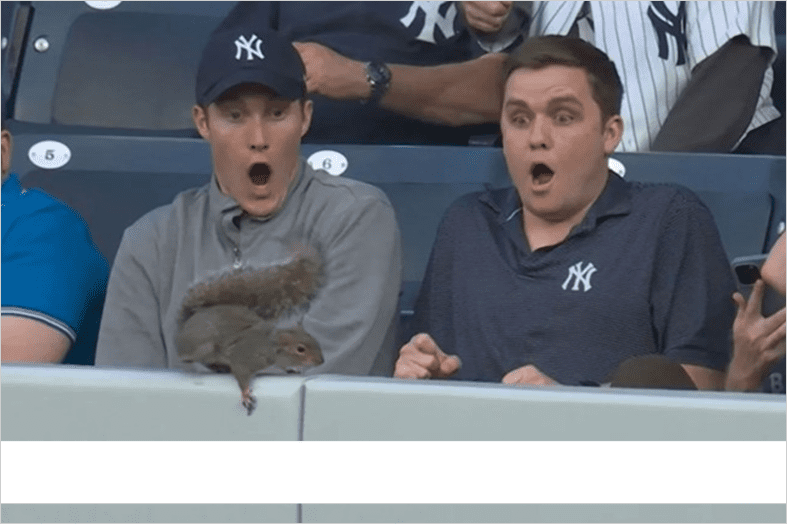
Source: Twitter
Consumers prioritise conservation, but in an increasingly urbanised and digitised society, how do we get people to value and connect with nature and its benefits?
In May, a video of New York Yankees fans marvelling as a squirrel enlivened a baseball game went viral, provoking much mirth and comment. Twitter respondent nycpitt’s question encapsulated the pervading sentiment: “These people ever seen a squirrel before?”
Climate change is driving migration. The World Bank reports that 216 million people will move within their countries by 2050—mostly to the cities. As the world urbanises (three million people already move into cities every week, according to the UN), two scenarios are developing.
One is that, as cities expand into natural habitats, we are alarmed by coming into closer contact with bats and rodents, which are responsible for 60% of the diseases transmitted from animals to humans, according to the UNDRR.
The other is that our city-slicker status further distances us from nature, compounding a situation where just 23% of us grow our own food in a garden or outdoor space such as a balcony. This rural/urban divide will also make it increasingly difficult for companies to ground their assertions around achieving carbon neutrality through forestation programmes in far-off locations.
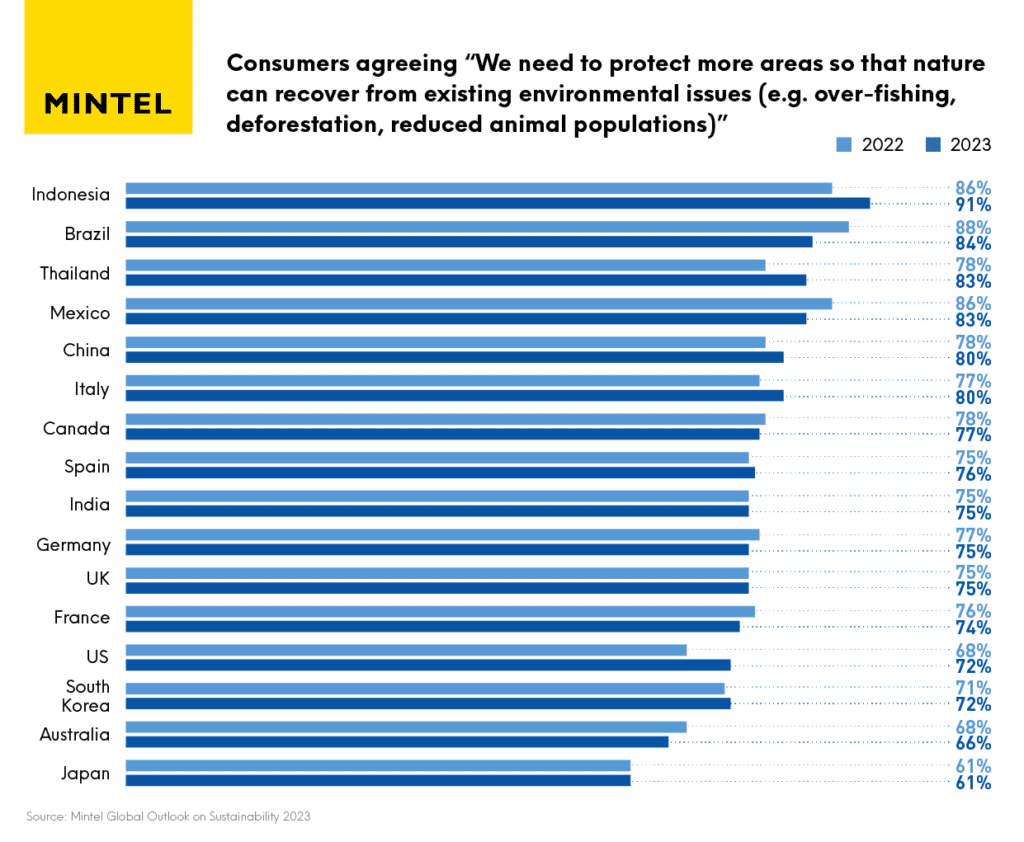
This is because, whilst 76% of consumers agree “we need to protect more areas so that nature can recover from existing environmental issues” (eg over-fishing, deforestation, reduced animal populations), just 66% say they “would prefer for companies to reduce their carbon emissions rather than use ‘Carbon Offsetting’ programmes outside of their area of business”.
Conservation is clearly something that we need to do (the WWF’s Living Planet Report 2022 reveals a 69% decline (on average) in monitored wildlife populations around the world between 1970 and 2018), yet, these measures and investments might be better suited to governments and multinationals than consumer-facing businesses.
The fact that consumer interest in conservation cools at the slightest sound of jargon—just 17% cite “loss of biodiversity on land” as one of their top three environmental concerns—emphasises how terminology, as much as geography, needs to be tangible to land with people.
One option is to sell in nature as a healthy city break—or in-city staycation—perhaps as Destination Canada has done by having doctors prescribe park passes because of the positive impact the outdoors has on physical and mental wellbeing.
Another is to leverage localism. The good news is that cities create communities with the capability to play upon neighbourhood provenance—be that through rewilding, urban farming or craft brewing. Here, natural benefits and the conservation and maximisation of local resources can hit home.
Initiatives like Cycloponics’ underground chicory and mushroom farm in Paris show what can be done with urban resources. The localised appeal of the Denver Beer Co is even broader, as it converts ‘local’ solar energy from 258kW worth of rooftop panels and captures 100,000lbs of CO2 onsite for use as a raw material at the nearby cannabis company, The Clinic.
Cities can become their own closed loops, but nature and its processes need to be re-incorporated into their fabric. For consumers, conservation—like charity—begins at home.
‘We the people’: Eco-litigation in the US and beyond
Published 28 June 2023
Let’s take a look at how the mobilisation and momentum around climate change litigation are creating an emerging compliance issue for consumer-facing businesses.
Earlier this month, sixteen young plaintiffs, aged 5-to-22, took to the US legal system to challenge the state of Montana’s fossil fuel-friendly policies on the basis that they contravene the state’s constitution and its commitment to “maintain and improve a clean and healthful environment in Montana for present and future generations”.
This is not an isolated case. We’re seeing a new generation of legal professionals who are starting to hold governments and businesses accountable to their electorates, shareholders, employees and customers on environmental grounds.
ClientEarth, for example, is a global team of lawyers seeking to ensure governments and companies are held accountable for damages and for upholding the Paris Agreements. The organization has successfully closed Poland’s Belchatów coal-fired power station because it contravened the owner’s obligation, according to Polish law, to take care of the public interest and public health.
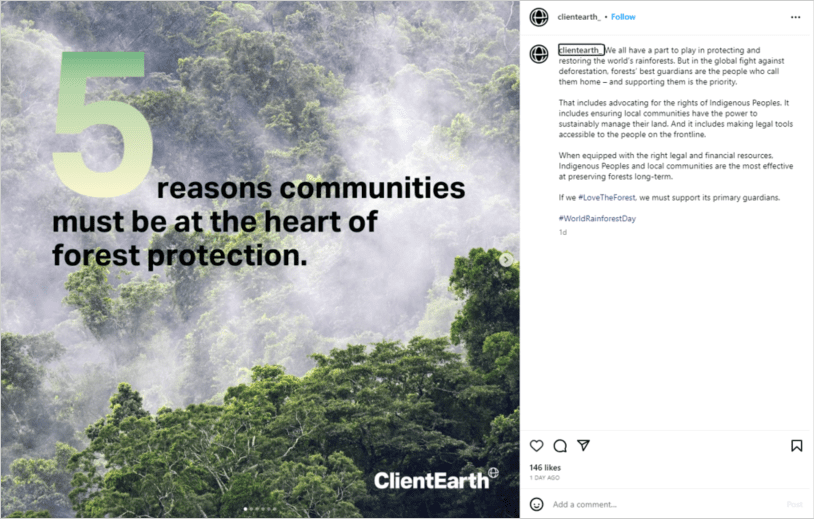
These are the latest episodes in an ongoing global legal drama that signposts how the line between corporate and governmental responsibility is blurring, whilst both parties are being challenged to do right by their respective customers, shareholders and electorates.
Data from Mintel’s Global Outlook on Sustainability report illustrates this point at a global level (see chart). Digging deeper into the US data, we see that growing numbers of Americans believe the government is most responsible for reducing the use of fossil fuels for energy (36%, up three points in the last 12 months), whilst 35% say companies are most responsible for increasing renewable energy usage. The fact that similar proportions agree that eco-activism is “a legitimate form of protest” and that it “has raised my awareness of environmental issues” suggests how burgeoning awareness will grow the eco-litigation trend.
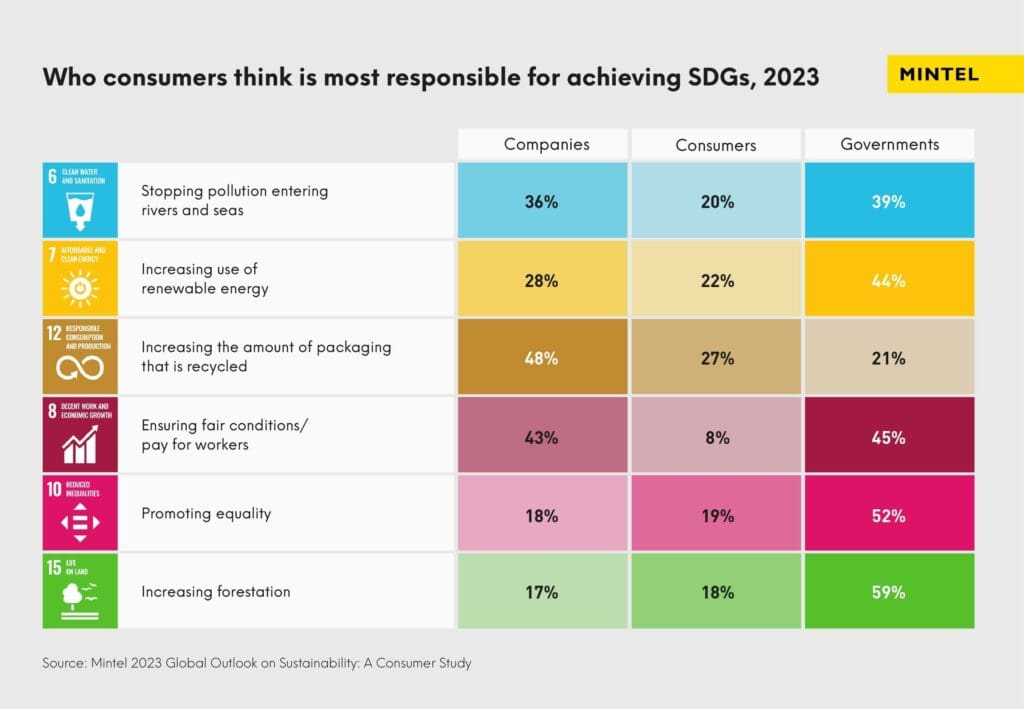
Compliance and avoiding punitive costs are classic components amongst the key arguments in the business case for companies to transition towards sustainability. However, it seems that companies have the most to fear. After all, initiatives like The Carbon Disclosure Project’s (CDP) Carbon Majors Database have revealed that, since 1988, just 50 companies have been responsible for three-quarters of greenhouse gas emissions from oil and gas.
Companies are about to find out that their responsibilities will no longer be confined to their shareholders and their levels of contentment but to a broader community of stakeholders who are impacted by those products and policies.
Mintel’s ‘Global Outlook on Sustainability: A Consumer Study’ was developed to help businesses lead effective change that resonates with and inspires consumers. The report tracks the environmental and social priorities, purchase behaviours, and levels of understanding of and engagement in sustainability topics among consumers from 16 countries. With the ever-increasing conversation around climate change and environmental concerns, now’s the time to get informed. Take advantage of this opportunity to focus your business goals on sustainability and improve your brand’s future viability and buy the report today.













